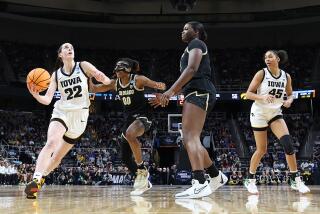Clark Hopes to Squash His Foes
- Share via
After graduating from Harvard in 1993, Marty Clark toured the world as a professional squash player for 3 1/2 years before returning to the United States to begin medical school.
Competing at a world-class level proved easier than convincing some medical school administrators that studies and squash on a scaled-back level were compatible.
“Some of the schools I interviewed at said, ‘You must be joking! This is medical school,’ ” Clark said. “I said, ‘You must be joking if you think I’m going to stop playing.’ I can’t imagine shutting my body down in my early 20s just for school. At some point in the next few years that may happen, but not now.”
Clark, 26, found a home at Columbia University in New York, where he is in his second year. And today, he is in Los Angeles to defend his pro title in the 16th annual U.S. Squash Championships.
The tournament, which has drawn more than 300 men and women in 22 pro and amateur divisions, is being played through Sunday at the Los Angeles Athletic Club, the Ketchum Downtown YMCA, the California Club, the Jonathan Club and Macy’s Plaza, where a portable, glass-walled court has been installed. Clark and the men’s pros are competing for a $20,000 first prize. Women are competing for $5,000.
This is the second time that the national championships for a sport rooted in tradition in the East have been in Southern California. The 1987 tournament was played in Long Beach.
Craig Brand, executive director of the U.S. Squash Racquets Assns., said about 500,000 Americans play squash at least once a year and that there are about 150,000 “hard-core” players in the United States.
“We’re seeing a lot of growth in participation in the sunny states in the West and in the South,” Brand said.
Squash was first played in England in the early 1800s by the pupils of a boarding school and made its way to the United States in the early 1900s. The standard international version is played on an enclosed court 21 feet wide by 32 feet long, though most Americans learn and play the game on racquetball courts 20 feet wide and 40 feet long.
The game derives its name from the soft, hollow balls that are literally squashed against the wall when struck by a players’ racket.
Clark has been playing squash since age 10 when his mother introduced him to the sport. By the time he finished high school, he was one of the top junior players in the nation.
Choosing a college was not difficult. The NCAA recognizes squash as a sport but does not sponsor intercollegiate championships. The Ivy League, however, is a squash hotbed.
“Pretty much the reason I went to Harvard was for squash,” said Clark, who led the Crimson to the Ivy League title in 1993. “There are other schools that play it, but there aren’t that many that take it seriously.”
Squash has full recognition as an Olympic sport, but it has yet to be contested during the Games.
“The sport has growth potential in the United States because we’re finally playing the version that’s played everywhere else in the world,” Clark said. “People will recognize that they can travel internationally with this sport. I think it will just sort of keep climbing along.”
More to Read
Go beyond the scoreboard
Get the latest on L.A.'s teams in the daily Sports Report newsletter.
You may occasionally receive promotional content from the Los Angeles Times.











